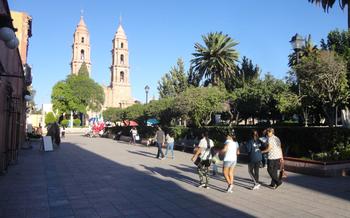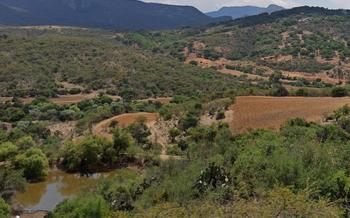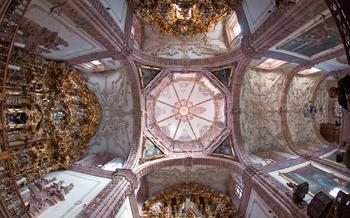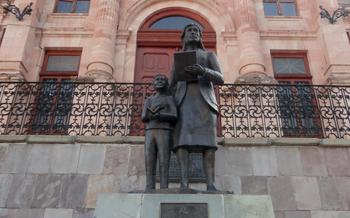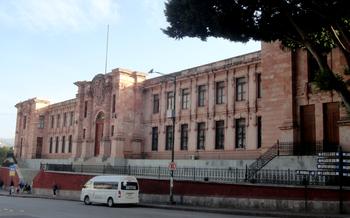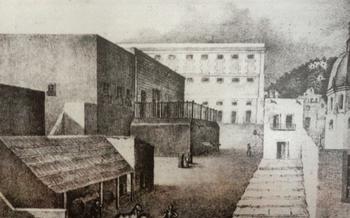
Guanajuato Mummy Museum (Museo de las Momias)
- Guanajuato Mummy Museum: A Macabre Masterpiece
- A Journey Through Time: The Museum's History
- The Mummies: Nature's Work of Art
- Exploring the Exhibits: A Walk Among the Dead
- Guanajuato's Unique Climate: A Natural Preserver
- Cultural Significance: Mummies as a Link to the Past
- Scientific Research: Unraveling the Mysteries
- Preservation and Conservation: Protecting the Past
- Educational Programs: Learning from the Mummies
- Exhibitions and Special Events: Beyond the Museum Walls
- Guanajuato's Other Treasures: Exploring the City
- Insider Tip: Hidden Gems in the Museum
Guanajuato Mummy Museum: A Macabre Masterpiece
In the heart of Guanajuato, a city steeped in history and legend, lies a museum that houses one of the most extraordinary collections of mummies in the world. The Guanajuato Mummy Museum, also known as the Museo de las Momias, is a testament to the city's unique climate and its role in preserving these bodies in an almost perfect state. Step into this macabre masterpiece and embark on a journey through time, where the mummies tell tales of life, death, and the enduring power of nature.
The Guanajuato Mummy Museum was established in the late 19th century, when workers stumbled upon a hidden cache of naturally mummified bodies in the city's cemetery. These mummies, remarkably well-preserved due to Guanajuato's dry and arid climate, quickly gained fame, attracting visitors from near and far. Today, the museum houses over 100 mummies, each with its own unique story to tell.
The cultural and scientific importance of these mummies cannot be overstated. They offer a rare glimpse into the lives and deaths of people who lived in Guanajuato centuries ago, providing valuable insights into pre-Hispanic cultures and burial practices. Moreover, the mummies themselves are a testament to the power of nature's preserving abilities, showcasing the unique conditions that led to their remarkable state of preservation.
A Journey Through Time: The Museum's History
The Guanajuato Mummy Museum is not just a showcase of preserved bodies; it's a journey through time, a testament to the city's rich history and the enduring power of human resilience. The story begins in the 19th century when a cholera epidemic swept through Guanajuato, claiming thousands of lives. In the aftermath, the city's cemeteries overflowed, and officials were forced to exhume bodies from older graves to make way for new burials.
It was during these exhumations that the mummies were discovered. To the astonishment of the workers, some of the bodies had naturally mummified, preserved by the city's unique climate. Initially, the mummies were stored in a crypt beneath the Panteón de San Paula, one of Guanajuato's oldest cemeteries. However, as their fame grew, it became clear that a more suitable home was needed.
In 1969, the Guanajuato Mummy Museum was established, transforming the former grain storage facility into a repository of the city's macabre treasures. Over the years, the museum has undergone several renovations and expansions, evolving into a state-of-the-art facility that not only showcases the mummies but also provides a comprehensive insight into their history and cultural significance.
Today, the Guanajuato Mummy Museum stands as a testament to the enduring fascination with death and the afterlife, a place where visitors can come face-to-face with the past and contemplate the fragility of human existence.
The Mummies: Nature's Work of Art
The mummies of Guanajuato are a unique testament to the power of nature's preservation. Unlike the artificially mummified bodies found in ancient Egypt, these mummies were naturally preserved due to the unique climate conditions of the region. The dry and arid environment, combined with the high altitude and acidic soil, created an ideal setting for natural mummification.
The mummies on display at the Guanajuato Mummy Museum vary in age, gender, and social status. There are adults, children, and even infants, each with their own unique story to tell. Some of the mummies are remarkably well-preserved, with intact skin, hair, and clothing. Others have been damaged by time and the elements, but their expressions and postures still convey a sense of their former lives.
The mummies of Guanajuato have become a source of fascination and intrigue for visitors from around the world. Their stories, both real and imagined, have captured the public's imagination and made them a symbol of the city's rich history and culture.
Exploring the Exhibits: A Walk Among the Dead
The exhibits at the Guanajuato Mummy Museum are a testament to the power of nature and the enduring fascination with death. The mummies are arranged in thematic sections, each highlighting different aspects of their lives and deaths. Visitors can learn about the mummification process, the diseases that afflicted the individuals, and the cultural significance of mummies in Mexican society.
Interactive displays provide insights into the lives of the mummies, showcasing their clothing, tools, and personal belongings. Multimedia presentations bring their stories to life, using audio-visual technology to recreate their final moments and shed light on their identities. Through these interactive elements, visitors can connect with the mummies on a deeper level and gain a greater appreciation for their unique history.
Guanajuato's Unique Climate: A Natural Preserver
Guanajuato's dry and arid climate plays a crucial role in the natural mummification process that has preserved the bodies on display in the Guanajuato Mummy Museum. The city's high altitude, combined with low humidity and constant airflow, creates an environment that promotes the rapid dehydration of the human body. This process, coupled with the unique soil conditions in the region, leads to the formation of natural mummies.
The scientific factors contributing to the mummification process in Guanajuato include the following:
-
Low humidity: The dry air in Guanajuato draws moisture away from the bodies, preventing the growth of bacteria and fungi that would otherwise decompose the flesh.
-
High altitude: The thin air at high altitudes reduces the oxygen available for decomposition, further slowing the decay process.
-
Constant airflow: The constant movement of air in Guanajuato helps to circulate the dry air around the bodies, promoting even dehydration.
-
Unique soil conditions: The soil in Guanajuato contains high levels of minerals, such as calcium and magnesium, which help to absorb moisture and further desiccate the bodies.
Guanajuato's unique climate has created a natural environment that is conducive to mummification, making it one of the few places in the world where naturally mummified bodies have been found. The mummies of Guanajuato offer a fascinating glimpse into the lives and deaths of people who lived in this region centuries ago, providing valuable insights into pre-Hispanic cultures and the natural processes that have shaped their preservation.
Cultural Significance: Mummies as a Link to the Past
The mummies of Guanajuato are not merely macabre exhibits; they hold profound cultural significance in Mexican history and tradition. In a country where the Day of the Dead is a vibrant celebration, these mummified remains serve as a poignant reminder of mortality and the enduring connection between the living and the deceased.
The Day of the Dead, a UNESCO-recognized cultural heritage event, is deeply rooted in Mexican culture and pre-Hispanic beliefs. During this time, families gather to remember and honor their deceased loved ones by creating altars adorned with marigolds, candles, and offerings. The mummies of Guanajuato echo this tradition, embodying the belief that death is not an end but a continuation of life in a different realm.
Moreover, the mummies provide a tangible link to pre-Hispanic civilizations, offering insights into the lives and customs of ancient Mexico. Their well-preserved clothing, jewelry, and artifacts provide clues about their social status, occupations, and cultural practices. By studying these mummies, researchers gain valuable knowledge about the history, traditions, and beliefs of the people who inhabited this region centuries ago.
Scientific Research: Unraveling the Mysteries
The mummies of Guanajuato have become a valuable source of information for anthropologists, scientists, and historians. Ongoing research conducted by experts from various disciplines aims to unravel the mysteries surrounding these naturally preserved bodies. Through detailed analyses and investigations, researchers strive to gain insights into the mummies' diet, lifestyle, and health conditions, shedding light on their lives and the society they belonged to.
Anthropologists and archaeologists meticulously examine the mummies' skeletal remains to understand their age, sex, and possible causes of death. They study the mummies' clothing, jewelry, and other artifacts to piece together their cultural background and social status. By analyzing the mummies' hair, teeth, and bones, scientists can determine their diet, nutritional status, and exposure to diseases.
The research conducted on the Guanajuato mummies has provided valuable contributions to our understanding of pre-Hispanic cultures in Mexico. By studying their DNA, scientists have been able to trace their genetic lineage and identify their ancestors. This research has shed light on the migrations, interactions, and genetic diversity of ancient Mexican populations.
Preservation and Conservation: Protecting the Past
Ensuring the longevity of these naturally preserved relics requires a delicate balance between conservation and public accessibility. The museum employs state-of-the-art climate control systems that mimic the dry conditions that fostered their mummification. Specialized techniques, such as humidity and temperature monitoring, prevent deterioration and maintain the integrity of the remains. Conservation experts meticulously examine and document each mummy, employing non-invasive methods to safeguard their fragile state. Balancing the need for preservation with the public's desire to witness these remarkable specimens presents a unique challenge. The Guanajuato Mummy Museum's dedication to preserving these artifacts ensures that future generations can continue to marvel at these captivating remnants of the past.
Educational Programs: Learning from the Mummies
The Guanajuato Mummy Museum is not merely a showcase of preserved bodies; it also serves as a valuable educational resource. The museum offers a range of programs designed to engage visitors of all ages and backgrounds, fostering a deeper understanding of the mummies and their significance.
Workshops, lectures, and guided tours are conducted regularly, providing insights into the history, culture, and scientific aspects of the mummies. Experienced guides share their knowledge about the mummification process, the lives and deaths of the individuals, and the ongoing research conducted on the remains.
The museum collaborates with schools and universities to develop educational programs tailored to students of different levels. Interactive activities, hands-on exhibits, and curriculum-aligned resources help bring the mummies to life for young learners, fostering curiosity and critical thinking.
Through these educational initiatives, the Guanajuato Mummy Museum promotes awareness about the cultural and scientific importance of the mummies, contributing to a broader understanding of pre-Hispanic cultures and the fascinating history of Guanajuato.
Exhibitions and Special Events: Beyond the Museum Walls
The Guanajuato Mummy Museum's influence extends beyond its physical walls. Its collection has traveled the world through itinerant exhibitions, showcasing the mummies and their stories to a global audience. These exhibitions offer a unique opportunity to experience the museum's treasures outside of Guanajuato, fostering cultural exchange and raising awareness about the significance of the mummies.
Additionally, the museum hosts thematic events and workshops that delve deeper into the world of mummification and related topics. These events provide a platform for experts, researchers, and enthusiasts to share their knowledge and insights. Visitors can participate in lectures, discussions, and hands-on activities, gaining a comprehensive understanding of the science, history, and cultural significance of mummies.
Through these initiatives, the Guanajuato Mummy Museum expands its reach, promoting cultural appreciation and fostering a sense of global community around the fascinating world of mummies.
Guanajuato's Other Treasures: Exploring the City
While the Mummy Museum is a must-see attraction, Guanajuato has a wealth of other treasures to offer visitors. The city's historic center, a UNESCO World Heritage Site, is a maze of cobblestone streets, colorful buildings, and charming plazas. Here, you can visit the Alhóndiga de Granaditas, a former granary that played a crucial role in the Mexican War of Independence, or admire the stunning architecture of the Teatro Juárez, one of Mexico's most beautiful theaters.
Guanajuato is also home to a number of other museums, including the Diego Rivera Museum, which houses a collection of the famous Mexican muralist's works, and the Regional Museum of Guanajuato, which offers a comprehensive overview of the state's history and culture. For those interested in religious art, the Templo de San Francisco is a must-visit, with its elaborate Churrigueresque facade and intricately carved interiors.
To experience the city's vibrant atmosphere, head to the Mercado Hidalgo, a bustling market where you can find everything from fresh produce and handicrafts to traditional Mexican street food. And in the evening, be sure to catch a performance at one of Guanajuato's many live music venues, where you can enjoy everything from traditional mariachi to modern rock.
By combining a visit to the Mummy Museum with other sightseeing in Guanajuato, you can create a truly memorable and enriching travel experience.
Insider Tip: Hidden Gems in the Museum
Beyond the main galleries, the Guanajuato Mummy Museum holds hidden treasures waiting to be discovered. One such gem is the "Secret Room," accessible through a discreet door in the museum's depths. Here, visitors can admire a collection of mummies that have been preserved in their original resting positions, offering a glimpse into their final moments.
Another hidden gem is the "Mummy of the Miner," tucked away in a corner of the museum. This mummy, remarkably well-preserved, showcases the harsh working conditions that miners faced in Guanajuato's silver mines during the 19th century.
For those seeking a truly immersive experience, guided tours often include access to restricted areas of the museum, such as the conservation laboratory. Here, visitors can witness firsthand the painstaking work involved in preserving these ancient remains.
